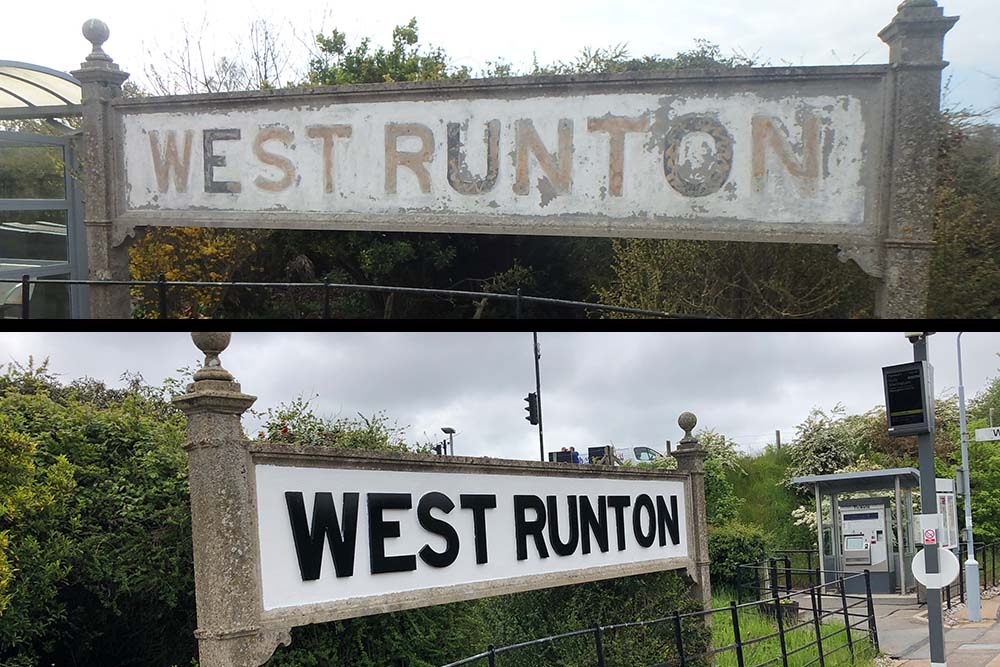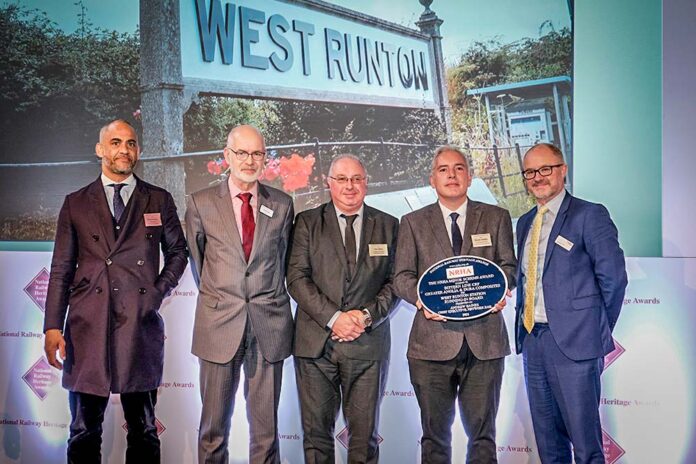A project in Norfolk to restore what is believed to be the last remaining railway sign of its kind on the national network has won an award.
The Bittern Line Community Rail Partnership, train operator Greater Anglia and Dura Composites scooped the top prize in the small projects category at the National Railway Heritage Awards.
The now-restored running-in board has welcomed passengers arriving at the West Runton station for 100 years. It was manufactured by the Midland and Great Northern Joint Railway (M&GNJR) at their engineering works in Melton Constable during 1921.
Despite extensive renovations in the early 1990s by leading M&GNJR expert Nigel Digby, the structure had fallen into disrepair in recent years as the wooden lettering suffered from the effects of weather. This recent restoration found a solution that is both authentic to the original structure and made from more sustainable materials.
Essex based Dura Composites, which specialises in GRP, undertake numerous projects across the rail network and, following a successful scheme for Greater Anglia in Suffolk, were asked if they could assist.
Volunteers from the Bittern Line Community Rail Partnership stripped the sign back to bare concrete and in researching the original font used for the lettering, found another at the former M&GNJR Gedney Station in Lincolnshire, which had closed to passengers in 1959. Experts from Dura were able to match the font used for the lettering and manufacture a new set using more robust materials.
In April, the company donated the new lettering and provided two members of their team to install them. Volunteers then returned to repaint the sign, and it was returned to its former glory in time for its 100th year.

Judges at the award praised the project for the “attention and care lavished upon the board, giving it visual appeal”, with its condition “a credit to those who originally manufactured the board at Melton Constable and the project team which have restored it.”
Martin Halliday, development officer for Community Rail Norfolk, said: “We were pleased to work with Greater Anglia and Dura Composites to restore this unique piece of railway infrastructure.
“The sign is a familiar landmark for many thousands of rail users and is undoubtedly one of the most iconic original station running-in boards still to be seen on the UK rail network.
“To be recognised at the National Railway Heritage Awards is a superb accolade for everyone involved in the project.”
Peter Mayne, chair of the Bittern Line Community Rail Partnership and its parent organisation, Community Rail Norfolk, said: “I am absolutely delighted to see this project to restore a unique and historically significant rail asset recognised by this national award.
“The restored station sign looks superb and is a great example of Community Rail at its best: A project identified by the Bittern Line CRP, supported by the community and taken forward in partnership with Greater Anglia through the generosity of Dura Composites Ltd, who supplied and installed the replacement letters at no cost.”
Greater Anglia’s head of asset management, Richard Turner, said, “I would like to thank everyone involved in this fantastic community rail project which has seen West Runton’s station sign restored to its former glory, providing a much more attractive first impression as people arrive by train.”
Tom Bowman, commercial director at Dura Composites said: “As we approach the 100th anniversary of the original sign’s installation, Dura Composites is proud to have played our part in restoring and preserving this important piece of railway history. By identifying the closest modern-day typographic match to the original 1920s lettering and replacing the degraded timber with a hardwearing composite, our team has helped create a renewed running-in board that will withstand the effects of the coastal climate and continue to be a familiar landmark for future generations of rail users.”







































 0113 2082620
0113 2082620 info@railbusinessdaily.com
info@railbusinessdaily.com 15 Mariner Court, Wakefield WF4 3FL
15 Mariner Court, Wakefield WF4 3FL

